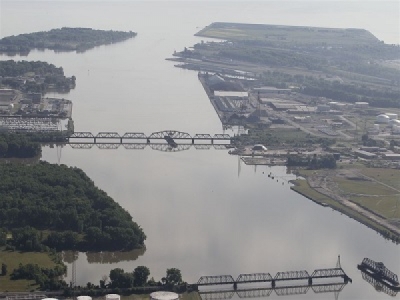
Posted on January 10, 2019
Nearly $10 million more in state funds are being released to help keep dredged material out of Lake Erie, including $1.9 million to the Toledo-Lucas County Port Authority to expand the capacity of its confined disposal facility near Oregon, known as Facility 3.
The latest round of grants was announced Tuesday at a news conference at One Maritime Plaza in Toledo. Ohio Environmental Protection Agency Director Craig Butler and Ohio Department of Natural Resources Director Jim Zehringer credited state Sen. Randy Gardner (R., Bowling Green) for his continued support. They said the grants will help Ohio come closer to meeting its goal of phasing out open-lake disposal of dredged shipping channel material from all of Lake Erie starting in 2020.
The Facility 3 money will be used to add storage capacity. The site should be able to take dredged material from the Maumee River shipping channel for eight to 10 more years once the expansion is finished. Without it, the cell would be filled to capacity in three to five years, said Paul Toth, Toledo-Lucas County Port Authority president and chief executive officer.
The extra five or six years “gives us a longer runway,” or window of time, for area engineers to come up with a long-term solution for open-lake disposal of dredged material, Mr. Toth said.
The local port authority spent about $1.2 million building up Facility 3’s dike walls in 2018 to fortify the structure. That allowed it to use up the remainder of a soil-like product called NuSoil that was still on site. Made in past years by a company called S & L Fertilizer Co., NuSoil was made of 88 percent soil dredged from the Toledo shipping channel, 10 percent sewage sludge, and 2 percent spent lime sludge from Toledo’s water treatment plant. S & L stopped making it about four years ago.
One of the possible solutions could be pumping Facility 3 dredged material out as a slurry on eastern Lucas County farms within a few years. That depends on the outcome of continued work being done at a North Toledo waterfront research park, where officials are studying the viability of growing crops with soil that has dredged material mixed in.
Scudder Mackay, Ohio DNR coastal management chief, said the projects are important to Lake Erie’s overall health because the federal government oversees eight commercial harbors along the shoreline that need to be dredged constantly to keep shipping viable.
An average of 35 million tons of cargo move through the government’s eight Lake Erie ports in Ohio, generating $25 billion in revenue and supporting 130,000 jobs, he said.
Two-thirds of the dredging — about 1 million of the 1.5 million cubic yards dredged annually from Ohio’s Lake Erie shipping channels — is done in the Toledo area. That’s because Toledo is by far the shallowest of all Great Lakes ports.
“We’re going to be dredging for years and are looking for long-term solutions,” Mr. Mackay said.
About another year or two of research is necessary at the Great Lakes Dredged Material Center for Innovation at Riverside Park in North Toledo. Funding for that research was announced a month before Toledo’s 2014 water crisis, when an algal toxin fouled the metro region’s tap water for almost three days.
“We’ve gotten a little farther along than we expected a couple of years ago. I would call it a success story to date,” Mr. Mackay said. “But we still have a long way to go.”
The cities of Lorain and Conneaut each received $4 million to build sediment processing facilities similar to one in Cleveland. Such a facility might eventually be considered in Toledo, but the technology would be more difficult because of the amount of fine silt in this part of the lake, he said.
Source: The Blade





